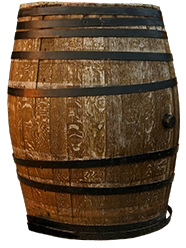The Roman era
The vine was introduced by Greek merchants as early as the 2nd century BC, but actually developed during the Roman occupation. The conditions were so favorable that the viticulture of the Narbonnaise shaded the “Italian” owners. The emperor demanded a limitation of production. This prosperity lasted until the end of Pax romana (period of peace from the first century to the second century AD, imposed by the Roman Empire to the controlled regions). It was at this time that the Roman TALARIUS established an important villa, where cereals, flax, olive and wines were grown!

HAUTES CORBIÈRES ALREADY OFFERED QUALITY WINE UNDER CHARLEMAGNE
Then it was the long parade of invaders. Peace returned with the monks, Benedictines and Cistercians, whose abbeys served as bases for the recolonization of the country. And the vine regained its rights: the wines of Lagrasse even seduced the sommelier of Charlemagne. In 834, the place became the property of the powerful lordship of Termes. Unfortunately this beautiful momentum was broken by the Albigensian crusade that came to exterminate the Cathar heresy. In 1271, one evokes the “Castrum of Talayrano”.
THE VINE TAKES ITS GEOGRAPHICAL RIGHTS BACK
Prosperity did not return until the eighteenth century and the rise of communications breaking the isolation of the Corbières. The compoix (cadastre of the time) of 1730 precisely gives the situation of the vineyard: “48 parcels of vine for a total of 20 hectares” exclusively reserved for family consumption. The completion of the Canal du Midi in the late seventeenth century will play an important role in the expansion of the vineyard.

THE BEGINNINGS OF QUALITY LABELS
In 1833, the land register covers 173 hectares. This extension is linked to the increase in population, trade with the high townships of Corbières and early commercialization. Ancient writings reveal that Talairan was already part of the “Vins Extra des Corbières”. The end of the nineteenth century experienced a strong disorganization of the French market undermined by fraud and overproduction.
1907: THE VINEYARD REVOLT AND THE BEGINNINGS OF THE DEFENCE UNIONS
The winemakers of Hautes Corbières will be heavily involved in the revolt of the winemakers of Languedoc in 1907. In 1908 the winemakers of Corbières organized themselves in defence union.

THE TERRITORY OF HAUTES CORBIÈRES IS STRUCTURED IN TERROIR OF APPELLATION
In 1923, the production area was delimited. In 1932, with this rich past, some courageous winemakers gathered to create our first winery. In 1951, the winemakers of Hautes Corbières can produce VDQS (Delimited Wines of Superior Quality). In 1960, the vineyard, with 688 hectares, becomes the major production of the territory of the Hautes Corbières, the breeding of sheep and the cultivation of cereals disappearing… At the time, almost every village had its own cooperative cellar.
THE WINES OF TERROIRS DU VERTIGE GET AOC
In 1985, the Corbières entered the family of Appellations of Controlled Origin. Since August 2009 and the adoption of the European regulation on wines, the AOC have officially become AOP (Protected Designation of Origin). The wines of the Terroirs du Vertige benefit from this quality label.

30 VILLAGES AND 170 WINE GROWERS
Terroirs du Vertige are the result of the merger of several small cooperative cellars because at the time, almost every village owned his own. Les Terroirs du Vertige is a cooperative cellar with 30 villages including Talairan, Jonquières, Lagrasse, Villerouge-Termenès, Montgaillard, Dernacueillette, Padern, Cucugnan …
The head office, the winemaking and breeding site are at Talairan (Aude 11220). 170 vine growers perpetuate the culture of the vine and wine combining ancestral methods and modernity. Picking, vinification and packaging in bottles are managed by us.
THE WINES OF TERROIRS DU VERTIGE OBTAIN HIGH ENVIRONMENTAL VALUE (HVE) CERTIFICATION
This certification allows recognition of our commitment to environmentally friendly procedures. This attests that the farms have a high level of biodiversity and very little use of inputs. With: the preservation of biodiversity thanks to areas free from any agricultural activity made up of hedges, trees, small bodies of water, ditches or even old agricultural plots set aside. These “ecological corridors” allow nature – fauna, flora, insects – to reinvest the environment and alternative practices contributing to a low level of inputs.

